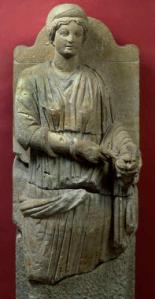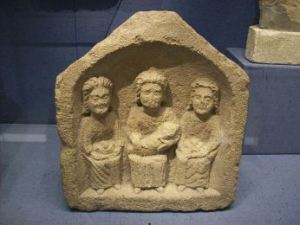My last post was about Sirona’s consorts and partners, but she did sometimes appear alone. We find her in inscriptions, and images, suggesting that her cult existed before the advent of the Romans.
Her cult not only spread itself over a wide swath of Europe, but was important enough to be joined with the emperor’s. (Tsirona, an alternate form of her name, and the emperor’s numen.) It centered on the Treveri‘s territory, in Gallia Belgica, but reached across north-west Europe.(Attestations to her cult are quite widely spread: from Brittany and southern Gaul to Germany, Hungary, and Noricum.)
The curative power of water was the center of Sirona’s cult. From the temple and bath complex at Hochscheid to her appearance at the spring at Luxeuil with Bricta and Luxovius, the common elements were healing, light and water.
She had several temples, all in the Roman style, rather than the Celtic nemeton of Belisama. They were of the fanum type, rather like a cloister, with an inner cella and an outer walkway. A thermal spring or well formed the center of these temples. Two inscriptions refer to people dedicating or restoring temples, one from Ihn-Niedaltdorf (CIL XIII, 04235) and one from Wiesbaden in Hesse (CIL XIII, 07570). An elaborate shrine and temple complex at Hochscheid in Germany was her cult’s biggest center. It was a popular pilgrimage site, despite being somewhat remote.
Although SIrona’s cult did predate the Romans, all the images we have of her come from Roman times, and filter the Celto-Germanic goddess through a Roman sensibility. But that imagery can tell us something about how her worshippers saw her. It’s also worth looking at the attributes she shared with other Celtic deities, to see what they might have had in common.
Hygeia/Salus
You know an image of Sirona by her snake, which looks like it’s feeding from a bowl of eggs she holds. This comes from the Greek goddess Hygeia, known to the Romans as Salus. Hygeia gives her name to hygiene, and Salus, in a more roundabout way, to words like salutary, meaning health-giving.
She was the daughter of the healer-god Asclepius. The Romans imported him wholesale, with a slight change of spelling. (Asklēpiós in Greek.) His name was said to mean “to cut open”, because Apollo cut him from his dead mother’s womb.
Coronis was dead at the time because 1) the plague got her, and Apollo intervened to save their son, or 2) she took another lover, and Apollo killed her, but saved their son from the funeral pyre.
Asclepius was sent to the centaur Chiron, a notable healer as well, as a foster-child, and learned his trade there. As a boy he did a snake a good turn, and in return it licked his ears and gave him wisdom. His father Apollo had the snake as a symbol as well, but in his case he killed the Python at Delphi, and replaced it with his own oracle.
Apollo’s healing power differed from his son’s as well. While they shared the by-name, Paean, Healer, the Romans imported Apollo stop an outbreak of plague. Unlike his son, Apollo’s power was double-faced, since he could either cause or cure disease. (He may have had this in common with the goddess Bricta.)
Ultimately, Asclepius’s own ability proved to be his downfall. He grew so powerful he could restore the dead to life. The stories vary as to how he met his end, but he died to keep the balance between living and dead. (One version has Hades feeling hard done by, and complaining to Zeus.)
His temples, called asclepions, housed a special type of non-venomous snake. They had free run of the dormitories where suppliants would try to dream or have a vision that the priest would interpret for them. In other sanctuaries dogs performed a similar service.
Hygeia was one of his five daughters, all of whom have names connected to health. (Panacea was another.) Hygeia prevented disease, through cleanliness and continuing good health. The Romans associated her with their goddess Valetudo, but as time went on she became closer to the goddess of social welfare, Salus. Her iconography did not change, although her name did, which would suggest that the Romans didn’t want to tamper with her cult.
Sirona’s imagery
Sirona’s imagery takes directly from Hygeia, as she often shown with the snake and bowl of eggs, both symbols of regeneration and rebirth. She may also have been a fertility-goddess, with the eggs representing the snake’s young. Damona and the Matres also had snakes, as well as the river-goddess Verbia, whose snakes represent her river. Snakes can stand for water (their rippling motion) and healing (sloughing skin), making them prefect for a goddess of healing waters.
Sirona sometimes has a dog, or fruit and flowers, like the Matres whose cult was so popular with the Celts. The dog symbolized both healing and the afterworld to the Celts and the Romans. (Remember that Asclepius had dogs in some of his temples, and Nodens’ temple in England had many votive images of dogs as offerings.) Lapdogs might have acted as hot water bottles for internal pain.
The fruit and flowers are obvious fertility and abundance symbols. These turn up in little votive images given by Sirona’s suppliants. Sometimes Sirona wears ears of grain, like Demeter or Ceres. They may also tie her to the Matres, or the goddess Matrona.
Green (103) thinks that a star-goddess, like the moon-goddess Diana, was linked to the menstrual cycle and childbirth. (We know that Diana and Sirona appeared together on inscriptions, and as statues in the Hochscheid temple.)
 Sirona’s attributes tell us she had healing power in her own right, and an alternate form of her name, Serona Sivelia, “She Who Makes Us Better”, from an inscription at Le Mans, reinforces this. Her partner, however, is Atesmerius, whose name comes from the same root as Rosmerta and Smertios, and means “Provider”.
Sirona’s attributes tell us she had healing power in her own right, and an alternate form of her name, Serona Sivelia, “She Who Makes Us Better”, from an inscription at Le Mans, reinforces this. Her partner, however, is Atesmerius, whose name comes from the same root as Rosmerta and Smertios, and means “Provider”.
This, along with the fruit and flowers she sometimes bears, suggest a fertility or prosperity aspect. In my first post I discussed why a star goddess would preside over a healing spring or well. If we imagine looking down into the water, and seeing faint points of light glimmering back, perhaps we can begin to see the central image of Sirona’s cult, both light in the dark sky, and the light that warms the depths and gives them power. Or, to put it another way, as above, so below.
References:
Adkins, Lesley and Roy A. Adkins 1996: Dictionary of Roman Religion, OUP.
Cormick, Finbar 1991: “The Dog in Prehistoric and Early Christian Ireland,” Archaeology Ireland 5/4 (Winter 1991): 7-9. (JSTOR)
Green, Miranda 1995: Celtic Goddesses: Warriors, Virgins and Mothers, British Museum Press.
Jenkins, Frank 1957: “The Role of the Dog in Romano-Gaulish Religion” Latomus 16: 60-76.
MacKillop, James 2004: A Dictoinary of Celtic Mythology, OUP.
Ross, Anne 1992: Pagan Celtic Britain: Studies in Iconography and Tradition, Constable and Sons.
If you like the image at the top, click here.




Pingback: Matrona: Mother Goddess – We Are Star Stuff
WONDERFUL! I use the asteroid Sirona in some of my charts, and this is one of the best summaries I’ve found. Thank you so much!! ❤
LikeLiked by 1 person
Glad you liked it!
LikeLike
Pingback: Sirona: her consorts – WE ARE STAR STUFF
Pingback: Bricta/Brixta: Dark Side of the Sun | We Are Star Stuff
Pingback: Irish Deities/Spirits | The Lefthander's Path
Pingback: Litavi the Earth-Goddess and Mars Cicolluis | We Are Star Stuff
Pingback: Eir: Goddess, Valkyrie and Healer | We Are Star Stuff